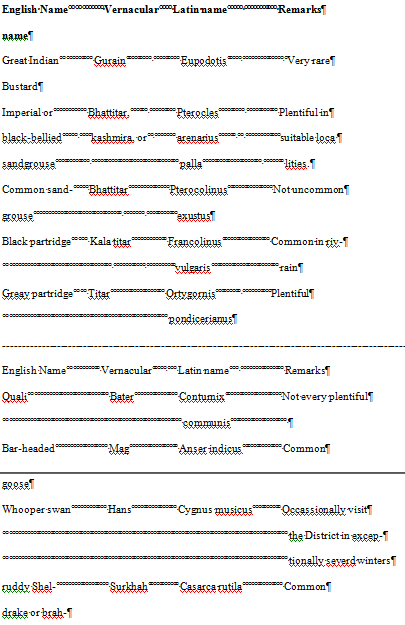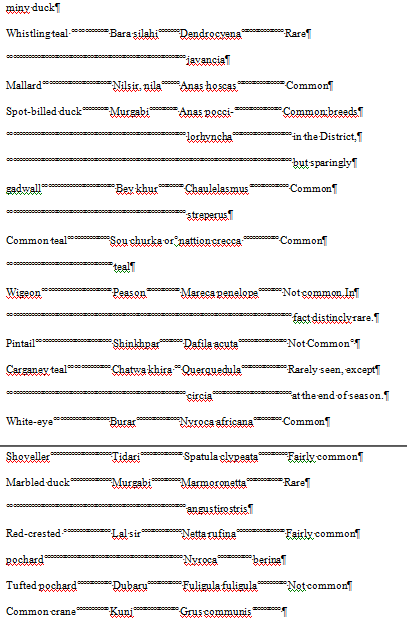The Firozpur District: Flora and Fauna
This is a collection of articles archived for the excellence of their content. Readers will be able to edit existing articles and post new articles directly |
The Firozpur District: Flora and Fauna
The Firozpur District is sparsely wooded. With a progressive increase in the area under cultivation, the scrub type of forest, which covered large tracts in the past, has almost disappeared. The scrub, which originally consisted of a thick growth of Salvadora oleioides Dene (van, mal), which yields the berries, known as pilu; Capparis decidua (Forsk.) Edgew. (karir or the leafless caper) and Acacia nilotica (L.) Wild. ex DC. Subsp. indica (Bth.) Brenan (kikar) are now represented by scattered trees of these species, which, however, from the common trees of the District.
In the south-west, Prosopis cineraria (L.) Druce (Jand) is frequently seen. Dalbergia sissoo Roxb. (shisam or tahli), Albizia leddeck Bth. (siris) are planted alongside the canal banks and roads. Among other trees seen in the District are the neem (Azadirachata Indica Zucc.) and the Bukain or Persian lilac (Melia, azedareh L.)
The well-grown trees of Tamarix aphylla (L). Karst. (pharwan) are seen along the canals. The earliest plantation of this species through cuttings dates back to 1876-79, according to the old Gazetteer of the and A. modesta Wall. (phulahi) are also seen. The ber, comprising two species of Zizyphus viz. Z. mauritiana Lamk., and Z. nummularia (Burm. f.) W. & A., are widely distributed, the latter, particularly in good soil. Near villages and on the edges of ponds, the pipal (Ficus religiosa L.) is frequently planted.
The wild date, pnoenix sylvestris (L) Roxb., is found near Firozpur and Fazilka.
The commonly cultivated fruit-trees of the District are mango, orange, lime, pomegranate and jamun. Banana is also grown.
The most widely distributed plant in the District is, perhaps, the akk (Calotropis procera (Ait.) Ait. It is very common in the poor sandy soil on fallow land and waste places. The plant sometimes attains a considerable size. The stems are used as firewood and also in the construction of huts by the poorer sections of the population. the roots of the this plant often harbour a parasite, Cistanch tubelosa Wt. (Orobanchaceae), which puts out its fleshy flowering spikes above the ground.
The flowers vary in colour from yellow to brownish purple. IN the canal-irrigated land and in abandoned fields, there occurs commonly a member of the onion family, viz. Asphodelus tenuifolius Ca., which is locally known as piazi or bhugaat. In the riverain tracts also occurs a plant which is quite conspicuous by its prickly habit. It is the jowanya (Alhagi pseudalhagi (Bib.) Desv., a low bushy plant with small reddish flowers. Along the river banks, another species of Tamarix, viz. T. dioica Roxb., locally known as pilchhi, forms a thick scrub and this is used largely as firewood.
The characteristic plant of the uplands is Aerva tomenstosa (Burm.f) Juss. (bui), with its dense woolly spike, giving a greyish-white appearance to the countryside where it abound; Crotalaria burhia Buch.—Hum ex. Bth., the wild Indian hemp, a wiry plant, with small yellow flowers; Farsetia Jacquemontii Hk. & T. (lathia), whose growth is indicative of baqd sand, and others. In the sandy soil, the trailing Citrullus colocvnthis (L.) Cogn. (tumma) of the gourd family occurs in profusion. Ephedra foliata Biss. is seen in dry places. An intruduced weed, now running wild and often proving to be a nuisance, is a thistle-like spiny plant, with yellow flowers, Carthamus oxyacanthus Bieb.
The useful grasses of the District include (Saccharum bengalense Retze = Munja Roxb.), locally known as sarr or sarkanda. It is particularly common in the riverain tracts. this grass finds many uses and the baan or munj fibre extracted from it is twisted into ropes or is used to make chairs and stools (moorhas).
Its stems are used for making huts and serve as fence poles. The young sprouts are sometimes used as fodder. Phragmiles karka (Retz.) Trin., a tall reedy grass, forming clumps in marshy places; (Eranthus ravennae (L.) P. Beauv., a tall robust grass; the doob grass, Cynodon dactylon (L.) pers.; Cenchrus ciliaris L. (dhaman) and the dabh or talla and Desmostachya bipinnata (L.) Stapf., a tufted grass, though useful as a sand-binder, all spread with great rapidity, sometimes proving troublesome. Some other grasses are also found in the District.
The plants of medicinal importance found in the District include Centella asiatica (L.) Urban (brahmi), (datura innoxia Mill. (dhatura), Grewia tenax (Forsk.) Fiori (ganger mewa); Pegamum harmala L. (harmal) and Withania somnifera (L.) Druce asgand or aksan).
Fauna
Animals—The Firozpur District contains but little of big game. The black buck is plentiful in the Bishnoi villages in the Fazilka, and is occasionally found in the areas near about. The nilgai is found in field areas of the Fazilka Tehsil and the hog-deer is found along the banks of River Satluj. An occasional wolf is brought in for reward. The wild boar abounds in the riverain jungles to the east of Firozpur, especially near Sobraon, but seems to have been exterminated in the west of Firozpur though there are a few of it in the Abohar silting tank and in the municipal reserve at Fazilka.
The wild ass and the tiger, which were sometimes founds in Fazilka, have long since disappeared. Jackals are common in the riverain tract and in the neighbourhood of towns, but are very rare in the uplands. The fox is found in the sandy parts of the District, whereas the hare is common. The otter is sometimes found along the River and near the large jheels. In the River itself, the tortoise is common. In many parts of the District, the field rats are so common that they have become a veritable plague and cause much damage to the crops. In buildings, the ordinary house rat is common. The mongoose (neola) is by no means rare.
Birds
With respect to bird life the District is much better off. The black partridge is common in the riverain tract, whereas the grey partridge is found in almost all places. In the sandy parts of the District sandgrouse, both the imperial and common varieties, are found the former being especially plentiful in the cold weather.
The latter is believed to breed in the District. The great Indian bustard is found on the Bikaner border. In the cold weather, various varieties of duck are to found on the jheels and in the River, whereas large flocks of the kunj or demoiselle crane daily wing their way inland from the River to the gram fields where they feed on the sundi (caterpillar). the common crane also is by no means rare.
The snipe and jack snipe are scarce. Large flocks of bar-headed geese are to be seen on the River and in the fields in the neighbourhood. The quail is not so plentiful as in some other districts. There are always a few about. Various varieties of plover occur, the commonest being the courier, grey, green, and goggle-eyed plovers; both the ordinary variety and the so called black variety of curlew are not uncommon.
Herons, pelicans, spoonbills, paddybirds, coots, cormorants and debchicks are plentiful in suitable localities, whereas the sarus and the black and white stork (chitror) are occasionally seen. The common blue pigeon is to be found everywhere, but the green pigeon is rare. At the beginning of the cold weather, large flocks of the eastern stock pigeon visit the District. Doves, crows, sparrow, starlings (mainas), and parrots occur in swarms, and the vultures and various varieties of hawks are also plentiful. Ravens are also not uncommon. In the cold weather, large flocks of starlings and the rosy pastor appear.
The following is a list of the game-birds found in the district :


